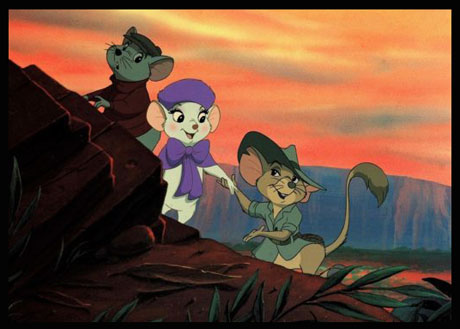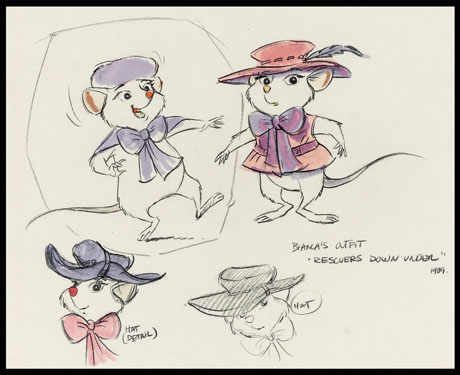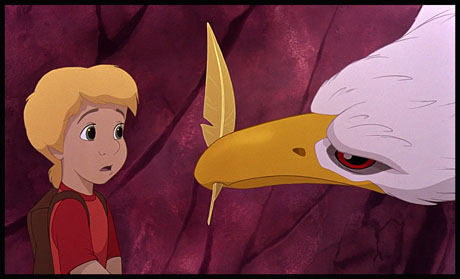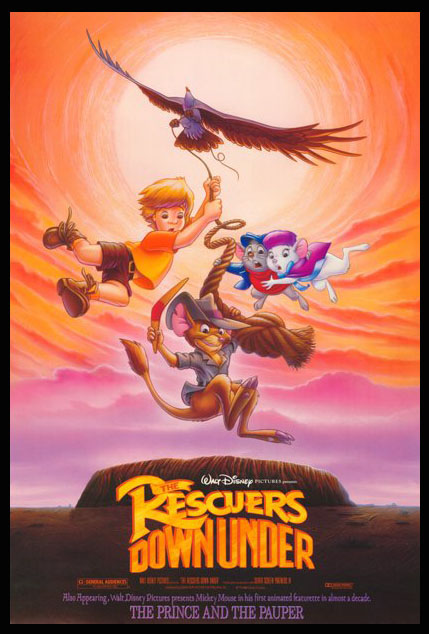
It was Monday, November 19th, 1990 and Home Alone had just opened, becoming a mammoth hit that blindsided Hollywood, going on to become one of the biggest movies of all time and a Christmas classic.
The John Hughes film also demolished any other movies competing against it at the box-office. One of these was The Rescuers Down Under, which had the unforeseen misfortune of opening on November 16th, 1990, the same day as Home Alone.

When the box-office results came in after opening weekend, Home Alone had taken the top spot with $17 million, while The Rescuers Down Under was fourth with $3.5 million. The family audience had spoken with their wallets, which prompted then Studio Chairman Jeffrey Katzenberg to pull all marketing and advertisement for the film. With this move, sadly, The Rescuers Down Under quietly withered away.
The years that followed at Disney animation would see success the likes of which hadn’t been seen since Walt himself roamed the halls. Films like Beauty and the Beast (1991), Aladdin (1992) and The Lion King (1994) were crowned as all part of a Second Golden Age, while animation history has seemingly remembered “The Rescuers Down Under” as a glossed-over forgotten stepchild of this era.
This is a shame and the film deserved so much better. Now marking its 30th anniversary, looking back at The Rescuers Down Under reveals a film that not only broke ground both technically and artistically, but was also an immensely entertaining sequel at a time when they were a rare thing at Disney.
Plans for a follow-up to 1977’s The Rescuers surfaced in the late ‘80’s, as Disney began to resuscitate and ramp-up production on animated films. The original film had a number of iterations, including a version set in Antarctica and another involving circus animals, which showed that there were plenty of possibilities for the characters.

The artists saw a number of opportunities for an environmentally-focused tale set in Australia, which would also allow for an all-out action-adventure film, a genre that the Studio had never explored before in animation.
The late, great legendary story artist Joe Ranft was brought on as story supervisor for “The Rescuers Down Under” and with the other artists, crafted a sequel that brought back Bernard and Bianca, the two diminutive mice heroes of the original film. Agents of The Rescue Aid Society, they travel the globe helping children in distress.
As we learn in the film’s remarkable opening sequence, a young Australian boy named Cody has come up against the treacherous poacher McLeach, who has trapped a beautiful, giant golden eagle named Marahute.
In snowy New York City, Bernard and Bianca board Wilbur the Albatross of Albatross Air Lines and go winging off to Australia.
Here, they meet Jake, the kangaroo mouse, who acts as their guide, to find Cody, who had been befriended by animals that were also captured by McLeach, including the frantic lizard, Frank.
The Rescue Aid Society Agents soon team-up with Cody to rescue Marahute from McLeach, as the adventure plays out against the backdrop of the Australian Outback, which is brought to life in all of its massive expanse and wonder.
Artists took early, pre-production trips to Australia, studying the landscape and many of the indigenous animals, which is evident in the film’s details. Directed by Mike Gabriel and Handel Butoy, The Rescuers Down Under unfurls like a perfectly-paced, action-adventure film. The co-directors looked to live-action director David Lean (who helmed such epics as “Lawrence of Arabia”) for inspiration, which is evident in a number of the film’s key scenes.

An opening, tracking shot across the Outback, immediately pulls the audience into the film and the setting; Wilbur attempting to take off during a snowstorm in Manhattan and flying over the Sydney Opera House in Australia are true, white-knuckle sequences and Bernard attempting to escape the treads of McLeach’s tank-like vehicle rivals sequences in any “Indiana Jones” film.
But, far and away, the most exhilarating sequence in The Rescuers Down Under comes early in the film, when Cody is rescued by and finds himself riding on the back of Marahute, the giant eagle. Soaring through clouds and over waterfalls, the feeling of flight is palpable. Without a doubt, it ranks as one of the Disney Studio’s most stunning examples of animation.
Oscar winner and master animator Glen Keane served as the supervisor for Marahute and studied eagles at the Peregrine Fund Conservation Center, while doing in-depth research on an eagle’s skeletal structure. All of this work is evident on-screen, in every move of Marahute, from the quick, twitching of her head, to the graceful movements of her wings.
The Rescuers Down Under brings back Bob Newhart and Eva Gabor as Bernard and Bianca and adds George C. Scott as McLeach, Tristan Rogers (the only Australian in the cast) as Jake and Wayne Robson as Frank.
Comedian Jim Jordan, who had voiced Orville the albatross in the original Rescuers, had sadly passed away before production. It was Roy E. Disney who came up with the idea of Orville’s brother Wilbur (as in the Wright brothers) having taken over the airline. John Candy was added to the cast to voice Wilbur. In an ironic twist, Candy also starred in Home Alone, which had bested Rescuers Down Under at the box-office.
While not generating these tremendous box office results, the film is landmark in how it utilized new technology that would change future animation production at Disney. The Rescuers Down Under was the first film to use the Computer Animation Production System (CAPS), a digital ink-and-paint and compositing system that allowed for a faster and more efficient production, replacing the time-consuming process of hand painting animation cels.
The film also extensively used Computer Generated Imagery, allowing for depth and a “live-action” feel to many sequences and elements, particularly McLeach’s truck.
As with any of the Studio’s strongest films, in The Rescuers Down Under, the film isn’t all about the technology and the visuals. There are nice, quiet moments of story and character, seen in the opening scenes between Cody and Marahute and in the running joke of Bernard’s constant attempts to propose to Bianca.
This is one of the reasons why, although eclipsed by Disney’s other animated features of the era, The Rescuers Down Under has deservedly gained an audience and attention over the past thirty years. So, this holiday season, as “30th anniversary love” is showered upon “Home Alone,” take some time to commemorate two little mice and their Australian adventure that helped set the stage for what was to come in Disney animation over the next decade.

- An Eye for A Classic: The 60th Anniversary of “Mr. Magoo’s Christmas Carol” - December 22, 2022
- A Very Merry Mickey: The 70th Anniversary of “Pluto’s Christmas Tree” - December 19, 2022
- A Fine French Feline Film: The 60th Anniversary of “Gay Pur-ee” - December 12, 2022


 November 6th, 2020
November 6th, 2020  Michael Lyons
Michael Lyons  Posted in
Posted in  Tags:
Tags: 






